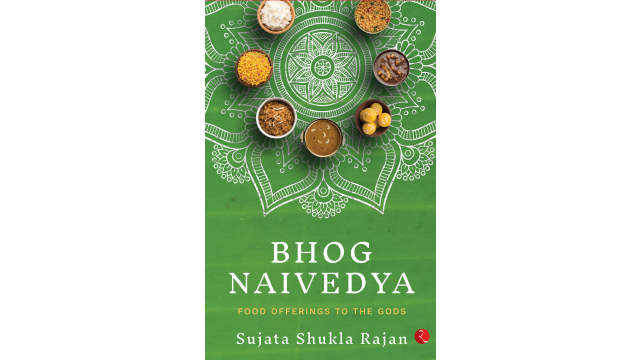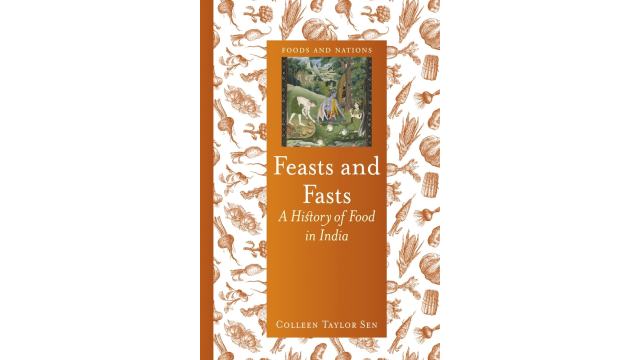Q&A with Shoba Narayan

Author and columnist Shoba Narayan belongs to a traditional Hindu vegetarian family, divides her time between India and the U.S., and writes about food, health, relationships, travel, and culture for global publications. Her lifelong mission: “to get fit without exercising and lose weight without dieting.”
Her fifth book, Food & Faith — A Pilgrim’s Journey Through India, is a record of her multi-faith pilgrimages across her home country. Here she talks about how stories, myths, and cuisine are linked through faith in India.
A columnist for over 30 years, she won a James Beard Award in 2001 and is a recipient of a Pulitzer Fellowship. Her first book, Monsoon Diary, released in 2003, was a memoir inspired by her family’s recipes and conversations around food. Narayan recalls visiting temples with “unrelenting frequency” while growing up.
Through the years, Narayan has learned that religious culinary traditions are part of India's continuing engagement with the past. She is keen on exploring India’s holistic approach toward food that includes feasting and fasting during its festive seasons. For Narayan, it’s a “fascinating exercise in reimagining history” to study India’s indigenous forms of medicine like Ayurveda, Unnani, and Siddha and their deep links to temple cuisine and sacred culinary practices.
Roundglass Food: Why do you say food is intimately related to faith and spirituality in India? How did you discover this?
Shoba Narayan: In 2015, I decided to go on a pilgrimage across India to approach faith through what I viewed as the most simple, innocuous, and primal fashion — through the prasadam or blessed food offerings in temples that are distributed to the pilgrims who visit the temples. If nothing else, I would eat well, I thought. But along the way, I wanted to figure out my faith.
My first question was simple: why do we have blessed food distributed in the first place? What is the purpose of sacred food? I discovered that one important aspect of temple food is the preservation of local varieties of rice, vegetables, and other crops. In a sense, it is basic sustainability. In Udupi, in south India for instance, the temple uses 18 varieties of local rice grains — such as Mullera, Rajakamala, Mattalaga, Padmarekha, Gouri, Ondkaddi, Honnekattu, Manjuguni Sannakki, Sindhu, and Tanu. Even with the specific foods made for the blessed offerings, you see local varieties of yam or colocasia and pumpkin and a local eggplant variety called matta gulla.
The takeaway is that long before global chefs were talking about eating seasonal, local, and regional food, our temples were doing this. Long before the whole world got into intermittent fasting, or IF, our ancestors were doing this. They were working on not just what we ate but when we ate and how much.
RG: What is your favorite ingredient?
SN: Asafetida or hing, because it is unique to Indian cooking or at least in the way that we use it. I have relatives in the US who sprinkle asafetida over every dish, almost like it is salt or pepper, just so they can get the taste of India. It is like what umami is for the Japanese.
RG: What’s a meal that you associate with wellbeing?
SN: Pongal or khichdi. This is a warm, comforting, one-pot meal that is well balanced in terms of taste and restrained with the use of spices typically associated with India. All it has are salt and pepper for the seasoning.
RG: What’s a mindful practice you follow while cooking/eating?
SN: A lot of Hindu households have mantra chanting on repeat as background. I tend to enjoy this, too.
RG: What is special about Indian festive cuisines?
SN: India, like all ancient cultures, is holistic in its approach towards food. Festival food alternates with fasting food so you have feasting and fasting simultaneously.
For example, traditional Hindus in Udupi don’t eat certain foods during the four monsoon months on the Hindu lunar calendar, a tradition of abstinence that seems at odds in this age when New Zealand apples and Malta oranges are airlifted to every region of India. They call this “four-month austerities,” and abstinence from certain types of food during the monsoon months. The protocol itself seems rather strict and forbidding but intuitive once you get used to it. It is similar to those keto or paleo diets that many of us have experimented with.
These four months also mark India’s festive calendar. So, there is literally feasting and fasting. The feasting involves certain prescribed foods. A naturopath once told me that a good way to get rid of toxins was to give up certain types of foods for a while to see what impact it had on your body. So, you gave up gluten one month; and dairy the next; meat, the third and fish, the fourth. On the one hand you have festive food that is connected to the seasons, availability of ingredients, but also fasting and austerities as part of it. It is a fine balance to achieve around food.
RG: What words of wisdom do you associate with food?
SN: That food has pleasures not linked just with taste, smell and sight. It is linked to memories and evokes the soul and spirit also.
RG: What aspect of cooking do you find relaxing?
SN: Recently, I have made my chopping of vegetables more tactile. For example, instead of using a knife to break apart broccoli, mushrooms or cauliflower, I do it with my bare hands. Instead of chopping tomatoes for the rasam, I just tear it apart with my hands.
RG: Do you have a kitchen hack for eating healthier?
SN: Eat less. Fast on a lunar cycle.
RG: If you could invite anyone over for dinner, who would you call and what would you serve them?
SN: Artist Louise Moillon, because I love her still life paintings and the fact that she was one of the few women artists who practiced this art during her time. I would serve her a duplication of one of her paintings which has gooseberries and strawberries in them.
RG: What’s an herb (or elixir, or fruit, or tea) that you associate with healing?
SN: Ginger tea, if possible, after every meal. And chewing fennel and cardamom after a meal.
RG: Do you have a favorite kitchen tool/treasured kitchen possession, whether for sentimental or utilitarian reasons (or both)?
SN: All the bronze vessels that have been passed down the generations in my household are treasured utensils. They are hard to find these days, even in Indian antique shops.
RG: Which previously unfamiliar dish changed your life? Where did you eat it?
SN: Over three decades ago, I had a lunch at Aquavit in New York. It taught me how restaurants could serve New American food in a way that was inventive and comforting. It was the first time I had encountered American fine dining. I will not forget it.
RG: What do you usually eat for breakfast?
SN: South Indian. Usually, dosas or idlis.
RG: What is your favorite season for cooking?
SN: Spring, because I love asparagus and that is when they become available.
RG: What’s a mindful practice around food that you cherish?
SN: Silence while cooking is an underrated practice that I cherish — not always easy to achieve in an Indian kitchen where people keep walking in and out and peppering you with questions.
RG: Is there a food experience that has transformed your life?
SN: The James Beard award dinner that I had in New York just before it was announced that I had won the MFK Fisher award for distinguished food writing was pretty transformative for my career. The dinner was spectacular because I was in the company of all the writers and editors that I admired. The fact that I won an award on that night was icing on the cake.
Key Takeaways
- Explore nutrition in temple cuisine.
- Temple cuisine is often gut friendly.
- Sacred food is seasonal and local.









